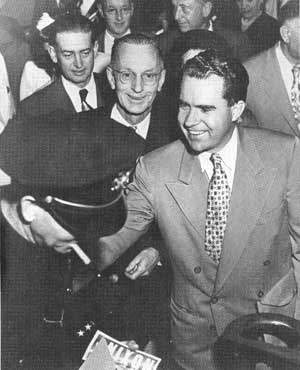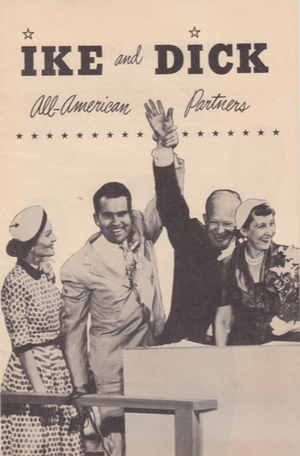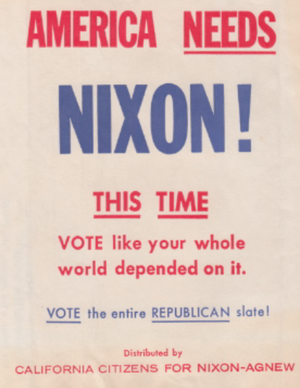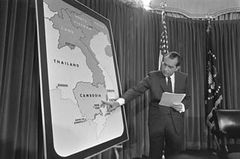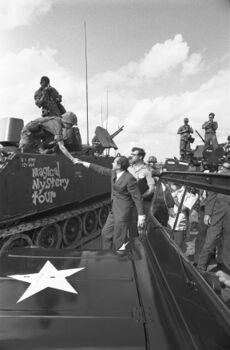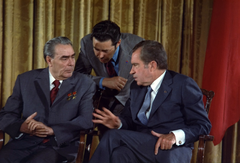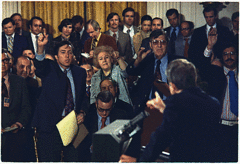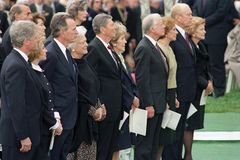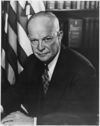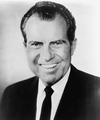ريتشارد نيكسون
| ريتشارد نيكسون Richard Nixon | |
|---|---|

| |
| رئيس الولايات المتحدة رقم 37 | |
| في المنصب 20 يناير 1969 – 9 أغسطس 1974 | |
| نائب الرئيس | سپيرو أگنيو جيرالد فورد |
| سبقه | ليندون جونسون |
| خلفه | جيرالد فورد |
| نائب الرئيس رقم 36 | |
| في المنصب 20 يناير 1953 – 20 يناير 1961 | |
| الرئيس | دوايت أيزنهاور |
| سبقه | ألبن باركلي |
| خلفه | ليندون جونسون |
| سناتور الولايات المتحدة عن كاليفورنيا | |
| في المنصب 4 ديسمبر 1950 – 1 يناير 1953 | |
| سبقه | Sheridan Downey |
| خلفه | Thomas Kuchel |
| عضو مجلس النواب الأمريكي عن الدائرة 12 في كاليفورنيا | |
| في المنصب 3 يناير 1947 – 1 ديسمبر1950 | |
| سبقه | Jerry Voorhis |
| خلفه | Patrick Hillings |
| تفاصيل شخصية | |
| وُلِد | 9 يناير 1913 يوربا ليندا، كاليفورنيا، الولايات المتحدة |
| توفي | 22 أبريل 1994 مدينة نيويورك، نيويورك، الولايات المتحدة |
| المدفن | Richard Nixon Presidential Library and Museum |
| الحزب | الحزب الجمهوري |
| الزوج | پات ريان (1940–93) |
| الأنجال | تريشيا جولي |
| الوالدان | |
| الجامعة الأم | كلية ويتيار Duke University |
| المهنة |
|
| المهنة | محامي |
| الدين | Quaker |
| التوقيع | |
| الخدمة العسكرية | |
| الخدمة/الفرع | البحرية الأمريكية |
| سنوات الخدمة | 1942–46 |
| الرتبة | Commander |
| المعارك/الحروب | World War II (Pacific War[1]) |
| ||
|---|---|---|
|
قبل نيابة الرئيس نائب رئيس الولايات المتحدة رقم 36 بعد نيابة الرئيس رئيس الولايات المتحدة رقم 37
التعيينات القضائية
السياسات
العهدة الأولى
العهدة الثانية
بعد الرئاسة الحملات الرئاسية  |
||
ريتشارد ميلهاوس نيكسون (9 يناير 1913 –22 أبريل 1994)، كان الرئيس الأمريكي السابع والثلاثين (1969–1974) ونائب الرئيس الأمريكي السادس والثلاثين (1953–1961). اضطر للتنحي في بداية فترة رئاسته الثانية بسبب فضيحة ووترجيت تحت وطأة تهديد الكونجرس بإدانته. كان زعيما للتيار العالمي (المضاد للتيار الإنغلاقي) داخل الحزب الجمهوري.
تميزت فترة الرئيس نيكسون، وبإسهام خاص من وزير خارجيته هنري كيسنجر، بإنجازاتها على صعيد السياسة الخارجية، من خلال انهاء التورط الأمريكي في ڤيتنام، وتطوير العلاقات مع كل من الصين الشعبية والاتحاد السوڤيتي. وقد شهدت فترة نيكسون، وبجهود كيسنجر الشخصية، التوصل إلى اتفاقيات الفصل بين القوات الإسرائيلية من جهة والسورية والمصرية من جهة أخرى، في أعقاب حرب أكتوبر 1973.[2]
ويرتبط اسم نيكسون بما يعرف بمبدأ نيكسون أو مبدأ گوام، والقائم على تركيز الدبلوماسية الأمريكية في آسيا على الأدوات الاقتصادية كبديل عن الأدوات العسكرية، وجعل الدول الآسيوية أكثر اعتماداً على نفسها في حل نزاعاتها، وتقييد التدخل الأمريكي وحصره في ردع التهديدات التي تمارسها إحدى القوى النووية، مع امكانية ردع التهديدات التقليدية التي تحدث على نطاق ضخم لا قبل لحلفاء أمريكا على مواجهتها.
حياته

ولد في 9 يناير 1913 في يوربا لنده، كاليفورنيا، وهو ينحدر من عائلة متدينة ذات أصول المانية كانت تعرف بإسم ميلهاوزن. وتخرج من كلية ويتيار، بكاليفورنيا في عام 1934، وفي كلية الحقوق بجامعة ديوك، درم، نورث كارولينا عام 1937. ثم أصبح شريكا في مؤسسة ويتيار القانونية. تم استدعاء نيكسون إلى الخدمة العسكرية في عام 1942، خلال الحرب العالمية الثانية. وقد عمل في وحدة نقل جوي بحرية في المحيط الهادي حتى نهاية الحرب عام 1945م. وترقى إلى رائد بحري.
حياته السياسية

عمله في الكونگرس
دخل نيكسون إلى السياسة عام 1946م عندما فاز بمقعد في مجلس النواب الأمريكي بعد حملة ضارية وطدت سمعته بوصفه معاديًا جريئًا للشيوعية. وأعيد انتخاب نيكسون، عن الحزب الجمهوري، إلى المجلس مرة أخرى في عام 1948م، وانتخب في مجلس الشيوخ الأمريكي عام 1950م. وأصبح نائبًا للرئيس دوايت أيزنهاور بين عامي 1953- 1961م.[3]
حملة الانتخابات الرئاسية عام 1952
انتخابات 1960 و1962
]
الانتخابات الرئاسية 1968
الرئاسة (1969–74)
سياسته الخارجية

كان الهدف الرئيسي لنيكسون تسوية حرب ڤتنام. وفي عام 1969م بدأ انسحابًا تدريجًيا للقوات القتالية الأمريكية من فيتنام، وأصبحت هذه السياسة تعرف بالڤتنمة. وأيدها عديد من الأمريكيين، لكن عددا آخر أرادوا إنهاء التورط الأمريكي فورًا. واكتسحت الاحتجاجات والمظاهرات البلاد بسبب استمرار الحرب.
خفف نيكسون من التوتر الذي ظل قائمًا عدة سنوات بين الولايات المتحدة وكل من الصين والاتحاد السوفييتي السابق. وفي عام 1972م أصبح أول رئيس أمريكي يزور الصين أثناء تولِّيه السلطة. كما زار الاتحاد السوفييتي سابقًا عام 1972م. وحصل على موافقة الكونجرس على الاتفاقية الأمريكية السوفييتية للحد من إنتاج الأسلحة النووية.
الصين
Nixon laid the groundwork for his overture to China before he became president, writing in Foreign Affairs a year before his election: "There is no place on this small planet for a billion of its potentially most able people to live in angry isolation."[4] Among the reasons that Nixon sought to improve relations with China was in the hope of weakening the Soviet Union and decreasing China's support to the North in the Vietnam War.[5] Nixon ultimately used the idea of gaining leverage against the Soviet Union through relations with China to obtain the support of key conservative figures including Barry Goldwater and Ronald Reagan.[6]
Assisting him in pursuing relations with China was Henry Kissinger, Nixon's national security advisor and future secretary of state. They collaborated closely, bypassing Cabinet officials. With relations between the Soviet Union and China at a nadir—border clashes between the two took place during Nixon's first year in office—Nixon sent private word to the Chinese that he desired closer relations. A breakthrough came in early 1971, when Chinese Communist Party (CCP) chairman Mao Zedong invited a team of American table tennis players to visit China and play against top Chinese players. Nixon followed up by sending Kissinger to China for clandestine meetings with Chinese officials.[4] On July 15, 1971, with announcements from Washington and Beijing, it was learned that the President would visit China the following February.[7] The secrecy had allowed both sets of leaders time to prepare the political climate in their countries for the visit.[8]
In February 1972, Nixon and his wife traveled to China after Kissinger briefed Nixon for over 40 hours in preparation.[9] Upon touching down, the President and First Lady emerged from Air Force One and were greeted by Chinese Premier Zhou Enlai. Nixon made a point of shaking Zhou's hand, something which then-secretary of state John Foster Dulles had refused to do in 1954 when the two met in Geneva.[10] More than a hundred television journalists accompanied the president. On Nixon's orders, television was strongly favored over printed publications, as Nixon felt that the medium would capture the visit much better than print. It also gave him the opportunity to snub the print journalists he despised.[10]
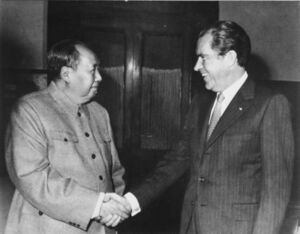
Nixon and Kissinger immediately met for an hour with CCP Chairman Mao Zedong and Premier Zhou at Mao's official private residence, where they discussed a range of issues.[11] Mao later told his doctor that he had been impressed by Nixon's forthrightness, unlike the leftists and the Soviets.[11] He said he was suspicious of Kissinger,[11] though the National Security Advisor referred to their meeting as his "encounter with history".[10] A formal banquet welcoming the presidential party was given that evening in the Great Hall of the People. The following day, Nixon met with Zhou; the joint communique following this meeting recognized Taiwan as a part of China and looked forward to a peaceful solution to the problem of reunification.[12] When not in meetings, Nixon toured architectural wonders, including the Forbidden City, the Ming tombs, and the Great Wall.[10] Americans took their first glance into everyday Chinese life through the cameras that accompanied Pat Nixon, who toured the city of Beijing and visited communes, schools, factories, and hospitals.[10]
The visit ushered in a new era of US–China relations.[13] Fearing the possibility of a US–China alliance, the Soviet Union yielded to pressure for détente with the United States.[14] This was one component of triangular diplomacy.[15]
حرب ڤيتنام
When Nixon took office, about 300 American soldiers were dying each week in Vietnam,[16] and the war was widely unpopular in the United States, the subject of ongoing violent protests. The Johnson administration had offered to suspend bombing unconditionally in exchange for negotiations, but to no avail. According to Walter Isaacson, Nixon concluded soon after taking office that the Vietnam War could not be won, and he was determined to end it quickly.[17] He sought an arrangement that would permit American forces to withdraw while leaving South Vietnam secure against attack.[18]
Nixon approved a secret B-52 carpet bombing campaign of North Vietnamese and Khmer Rouge positions in Cambodia beginning in March 1969 and code-named Operation Menu, without the consent of Cambodian leader Norodom Sihanouk.[19][20][21] In mid-1969, Nixon began efforts to negotiate peace with the North Vietnamese, sending a personal letter to their leaders, and peace talks began in Paris. Initial talks did not result in an agreement,[22] and in May 1969 he publicly proposed to withdraw all American troops from South Vietnam provided North Vietnam did so, and suggesting South Vietnam hold internationally supervised elections with Viet Cong participation.[23]
In July 1969, Nixon visited South Vietnam, where he met with his U.S. military commanders and President Nguyễn Văn Thiệu. Amid protests at home demanding an immediate pullout, he implemented a strategy of replacing American troops with Vietnamese troops, known as "Vietnamization".[13] He soon instituted phased U.S. troop withdrawals,[24] but also authorized incursions into Laos, in part to interrupt the Ho Chi Minh trail passing through Laos and Cambodia and used to supply North Vietnamese forces. In March 1970, at the explicit request of the Khmer Rouge and negotiated by Pol Pot's then-second-in-command, Nuon Chea, North Vietnamese troops launched an offensive and overran much of Cambodia.[25] Nixon announced the ground invasion of Cambodia on April 30, 1970, against North Vietnamese bases in the east of the country,[26] and further protests erupted against perceived expansion of the conflict, which resulted in Ohio National Guardsmen killing four unarmed students at Kent State University.[27] Nixon's responses to protesters included an impromptu, early morning meeting with them at the Lincoln Memorial on May 9, 1970.[28][29][30] Nixon's campaign promise to curb the war, contrasted with the escalated bombing, led to claims that Nixon had a "credibility gap" on the issue.[24] It is estimated that between 50,000 and 150,000 people were killed during the bombing of Cambodia between 1970 and 1973.[20]
In 1971, excerpts from the "Pentagon Papers", which had been leaked by Daniel Ellsberg, were published by The New York Times and The Washington Post. When news of the leak first appeared, Nixon was inclined to do nothing; the Papers, a history of United States' involvement in Vietnam, mostly concerned the lies of prior administrations and contained few real revelations. He was persuaded by Kissinger that the Papers were more harmful than they appeared, and the President tried to prevent publication, but the Supreme Court ruled in favor of the newspapers.[31]
As U.S. troop withdrawals continued, conscription was phased out by 1973, and the armed forces became all-volunteer.[32] After years of fighting, the Paris Peace Accords were signed at the beginning of 1973. The agreement implemented a cease fire and allowed for the withdrawal of remaining American troops without requiring withdrawal of the 160,000 North Vietnam Army regulars located in the South.[33] Once American combat support ended, there was a brief truce, before fighting resumed, and North Vietnam conquered South Vietnam in 1975.[34]
سياسته مع أمريكا اللاتينية

Nixon had been a firm supporter of Kennedy during the 1961 Bay of Pigs Invasion and 1962 Cuban Missile Crisis. On taking office in 1969, he stepped up covert operations against Cuba and its president, Fidel Castro. He maintained close relations with the Cuban-American exile community through his friend, Bebe Rebozo, who often suggested ways of irritating Castro. The Soviets and Cubans became concerned, fearing Nixon might attack Cuba and break the understanding between Kennedy and Khrushchev that ended the missile crisis. In August 1970, the Soviets asked Nixon to reaffirm the understanding, which he did, despite his hard line against Castro. The process was not completed before the Soviets began expanding their base at the Cuban port of Cienfuegos in October 1970. A minor confrontation ensued, the Soviets stipulated they would not use Cienfuegos for submarines bearing ballistic missiles, and the final round of diplomatic notes were exchanged in November.[35]
The election of Marxist candidate Salvador Allende as President of Chile in September 1970 spurred a vigorous campaign of covert opposition to him by Nixon and Kissinger.[36] This began by trying to convince the Chilean congress to confirm Jorge Alessandri as the winner of the election, and then messages to military officers in support of a coup.[36] Other support included strikes organized against Allende and funding for Allende opponents. It was even alleged that "Nixon personally authorized" $700,000 in covert funds to print anti-Allende messages in a prominent Chilean newspaper.[36] Following an extended period of social, political, and economic unrest, General Augusto Pinochet assumed power in a violent coup d'état on September 11, 1973; among the dead was Allende.[37]
الاتحاد السوڤيتي
Nixon used the improving international environment to address the topic of nuclear peace. Following the announcement of his visit to China, the Nixon administration concluded negotiations for him to visit the Soviet Union. The President and First Lady arrived in Moscow on May 22, 1972, and met with Leonid Brezhnev, the general secretary of the Communist Party; Alexei Kosygin, the Chairman of the Council of Ministers; and Nikolai Podgorny, the Chairman of the Presidium of the Supreme Soviet, among other leading Soviet officials.[38]
Nixon engaged in intense negotiations with Brezhnev.[38] Out of the summit came agreements for increased trade and two landmark arms control treaties: SALT I, the first comprehensive limitation pact signed by the two superpowers,[13] and the Anti-Ballistic Missile Treaty, which banned the development of systems designed to intercept incoming missiles. Nixon and Brezhnev proclaimed a new era of "peaceful coexistence". A banquet was held that evening at the Kremlin.[38]
Nixon and Kissinger planned to link arms control to détente and to the resolution of other urgent problems through what Nixon called "linkage." David Tal argues:
The linkage between strategic arms limitations and outstanding issues such as the Middle East, Berlin and, foremost, Vietnam thus became central to Nixon's and Kissinger's policy of détente. Through the employment of linkage, they hoped to change the nature and course of U.S. foreign policy, including U.S. nuclear disarmament and arms control policy, and to separate them from those practiced by Nixon's predecessors. They also intended, through linkage, to make U.S. arms control policy part of détente ... His policy of linkage had in fact failed. It failed mainly because it was based on flawed assumptions and false premises, the foremost of which was that the Soviet Union wanted strategic arms limitation agreement much more than the United States did.[39]
Seeking to foster better relations with the United States, China and the Soviet Union both cut back on their diplomatic support for North Vietnam and advised Hanoi to come to terms militarily.[40] Nixon later described his strategy:
I had long believed that an indispensable element of any successful peace initiative in Vietnam was to enlist, if possible, the help of the Soviets and the Chinese. Though rapprochement with China and détente with the Soviet Union were ends in themselves, I also considered them possible means to hasten the end of the war. At worst, Hanoi was bound to feel less confident if Washington was dealing with Moscow and Beijing. At best, if the two major Communist powers decided that they had bigger fish to fry, Hanoi would be pressured into negotiating a settlement we could accept.[41]
In 1973, Nixon encouraged the Export-Import Bank to finance in part a trade deal with the Soviet Union in which Armand Hammer's Occidental Petroleum would export phosphate from Florida to the Soviet Union, and import Soviet ammonia. The deal, valued at $20 billion over 20 years, involved the construction of two major Soviet port facilities at Odessa and Ventspils,[42][43][44] and a pipeline connecting four ammonia plants in the greater Volga region to the port at Odessa.[44] In 1973, Nixon announced his administration was committed to seeking most favored nation trade status with the USSR,[45] which was challenged by Congress in the Jackson-Vanik Amendment.[46]
During the previous two years, Nixon had made considerable progress in U.S.–Soviet relations, and he embarked on a second trip to the Soviet Union in 1974.[47] He arrived in Moscow on June 27 to a welcome ceremony, cheering crowds, and a state dinner at the Grand Kremlin Palace that evening.[47] Nixon and Brezhnev met in Yalta, where they discussed a proposed mutual defense pact, détente, and MIRVs. Nixon considered proposing a comprehensive test-ban treaty, but he felt he would not have time to complete it during his presidency.[47] There were no significant breakthroughs in these negotiations.[47]
سياسته مع الشرق الأوسط

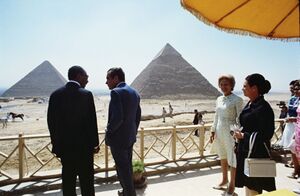
As part of the Nixon Doctrine, the U.S. avoided giving direct combat assistance to its allies and instead gave them assistance to defend themselves. During the Nixon administration, the U.S. greatly increased arms sales to the Middle East, particularly Israel, Iran and Saudi Arabia.[48] The Nixon administration strongly supported Israel, an American ally in the Middle East, but the support was not unconditional. Nixon believed Israel should make peace with its Arab neighbors and that the U.S. should encourage it. The president believed that—except during the Suez Crisis—the U.S. had failed to intervene with Israel, and should use the leverage of the large U.S. military aid to Israel to urge the parties to the negotiating table. The Arab-Israeli conflict was not a major focus of Nixon's attention during his first term—for one thing, he felt that no matter what he did, American Jews would oppose his reelection.[أ]
On October 6, 1973, an Arab coalition led by Egypt and Syria, supported with arms and materiel by the Soviet Union, attacked Israel in the Yom Kippur War. Israel suffered heavy losses and Nixon ordered an airlift to resupply Israeli losses, cutting through inter-departmental squabbles and bureaucracy and taking personal responsibility for any response by Arab nations. More than a week later, by the time the U.S. and Soviet Union began negotiating a truce, Israel had penetrated deep into enemy territory. The truce negotiations rapidly escalated into a superpower crisis; when Israel gained the upper hand, Egyptian president Sadat requested a joint U.S.–USSR peacekeeping mission, which the U.S. refused. When Soviet Premier Brezhnev threatened to unilaterally enforce any peacekeeping mission militarily, Nixon ordered the U.S. military to DEFCON3,[49] placing all U.S. military personnel and bases on alert for nuclear war. This was the closest the world had come to nuclear war since the Cuban Missile Crisis. Brezhnev backed down as a result of Nixon's actions.[50]
Because Israel's victory was largely due to U.S. support, the Arab OPEC nations retaliated by refusing to sell crude oil to the U.S., resulting in the 1973 oil crisis.[51] The embargo caused gasoline shortages and rationing in the United States in late 1973, and was eventually ended by the oil-producing nations as peace in the Middle East took hold.[52]
After the war, and under Nixon's presidency, the U.S. reestablished relations with Egypt for the first time since 1967. Nixon used the Middle East crisis to restart the stalled Middle East Peace Negotiations; he wrote in a confidential memo to Kissinger on October 20:
I believe that, beyond a doubt, we are now facing the best opportunity we have had in 15 years to build a lasting peace in the Middle East. I am convinced history will hold us responsible if we let this opportunity slip by ... I now consider a permanent Middle East settlement to be the most important final goal to which we must devote ourselves.[53]
Nixon made one of his final international visits as president to the Middle East in June 1974, and became the first president to visit Israel.[54]
السياسة المحلية

الاقتصاد
At the time Nixon took office in 1969, inflation was at 4.7 percent—its highest rate since the Korean War. The Great Society had been enacted under Johnson, which, together with the Vietnam War costs, was causing large budget deficits. Unemployment was low, but interest rates were at their highest in a century.[55] Nixon's major economic goal was to reduce inflation; the most obvious means of doing so was to end the war.[55] This could not be accomplished overnight, and the U.S. economy continued to struggle through 1970, contributing to a lackluster Republican performance in the midterm congressional elections (Democrats controlled both Houses of Congress throughout Nixon's presidency).[56] According to political economist Nigel Bowles in his 2011 study of Nixon's economic record, the new president did little to alter Johnson's policies through the first year of his presidency.[57]
Nixon was far more interested in foreign affairs than domestic policies, but believed that voters tend to focus on their own financial condition, and that economic conditions were a threat to his reelection. As part of his "New Federalism" views, he proposed grants to the states, but these proposals were for the most part lost in the congressional budget process. However, Nixon gained political credit for advocating them.[56] In 1970, Congress had granted the President the power to impose wage and price freezes, though the Democratic majorities, knowing Nixon had opposed such controls through his career, did not expect Nixon to actually use the authority.[57] With inflation unresolved by August 1971, and an election year looming, Nixon convened a summit of his economic advisers at Camp David. He then announced temporary wage and price controls, allowed the dollar to float against other currencies, and ended the convertibility of the dollar into gold.[58] Bowles points out,
by identifying himself with a policy whose purpose was inflation's defeat, Nixon made it difficult for Democratic opponents ... to criticize him. His opponents could offer no alternative policy that was either plausible or believable since the one they favored was one they had designed but which the president had appropriated for himself.[57]
Nixon's policies dampened inflation through 1972, although their aftereffects contributed to inflation during his second term and into the Ford administration.[58]
After Nixon won re-election, inflation was returning.[59] He reimposed price controls in June 1973. The price controls became unpopular with the public and businesspeople, who saw powerful labor unions as preferable to the price board bureaucracy.[59] The controls produced food shortages, as meat disappeared from grocery stores and farmers drowned chickens rather than sell them at a loss.[59] Despite the failure to control inflation, controls were slowly ended, and on April 30, 1974, their statutory authorization lapsed.[59]
المبادرات الحكومية


Nixon advocated a "New Federalism", which would devolve power to state and local elected officials, though Congress was hostile to these ideas and enacted few of them.[60] He eliminated the Cabinet-level United States Post Office Department, which in 1971 became the government-run United States Postal Service.[61]
Nixon was a late supporter of the conservation movement. Environmental policy had not been a significant issue in the 1968 election, and the candidates were rarely asked for their views on the subject. Nixon broke new ground by discussing environmental policy in his State of the Union speech in 1970. He saw that the first Earth Day in April 1970 presaged a wave of voter interest on the subject, and sought to use that to his benefit; in June he announced the formation of the Environmental Protection Agency (EPA).[62] He relied on his domestic advisor John Ehrlichman, who favored protection of natural resources, to keep him "out of trouble on environmental issues."[63] Other initiatives supported by Nixon included the Clean Air Act of 1970 and the Occupational Safety and Health Administration (OSHA), and the National Environmental Policy Act required environmental impact statements for many Federal projects.[63][62] Nixon vetoed the Clean Water Act of 1972—objecting not to the policy goals of the legislation but to the amount of money to be spent on them, which he deemed excessive. After Congress overrode his veto, Nixon impounded the funds he deemed unjustifiable.[64]
In 1971, Nixon proposed health insurance reform—a private health insurance employer mandate,[ب] federalization of Medicaid for poor families with dependent minor children,[65] and support for health maintenance organizations (HMOs).[66] A limited HMO bill was enacted in 1973.[66] In 1974, Nixon proposed more comprehensive health insurance reform—a private health insurance employer mandate[ب] and replacement of Medicaid by state-run health insurance plans available to all, with income-based premiums and cost sharing.[67]
Nixon was concerned about the prevalence of domestic drug use in addition to drug use among American soldiers in Vietnam. He called for a war on drugs and pledged to cut off sources of supply abroad. He also increased funds for education and for rehabilitation facilities.[68]
As one policy initiative, Nixon called for more money for sickle-cell research, treatment, and education in February 1971[69] and signed the National Sickle Cell Anemia Control Act on May 16, 1972.[70][71][ت] While Nixon called for increased spending on such high-profile items as sickle-cell disease and for a war on cancer, at the same time he sought to reduce overall spending at the National Institutes of Health.[72]
الحقوق المدنية
The Nixon presidency witnessed the first large-scale integration of public schools in the South.[73] Nixon sought a middle way between the segregationist Wallace and liberal Democrats, whose support of integration was alienating some Southern whites.[74] Hopeful of doing well in the South in 1972, he sought to dispose of desegregation as a political issue before then. Soon after his inauguration, he appointed Vice President Agnew to lead a task force, which worked with local leaders—both white and black—to determine how to integrate local schools. Agnew had little interest in the work, and most of it was done by Labor Secretary George Shultz. Federal aid was available, and a meeting with President Nixon was a possible reward for compliant committees. By September 1970, less than ten percent of black children were attending segregated schools. By 1971, however, tensions over desegregation surfaced in Northern cities, with angry protests over the busing of children to schools outside their neighborhood to achieve racial balance. Nixon opposed busing personally but enforced court orders requiring its use.[75]
Some scholars, such as James Morton Turner and John Isenberg, believe that Nixon, who had advocated for civil rights in his 1960 campaign, slowed down desegregation as president, appealing to the racial conservatism of Southern whites, who were angered by the civil rights movement. This, he hoped, would boost his election chances in 1972.[76][77]
In addition to desegregating public schools, Nixon implemented the Philadelphia Plan in 1970—the first significant federal affirmative action program.[78] He also endorsed the Equal Rights Amendment after it passed both houses of Congress in 1972 and went to the states for ratification.[79] He also pushed for African American civil rights and economic equity through a concept known as black capitalism.[80] Nixon had campaigned as an ERA supporter in 1968, though feminists criticized him for doing little to help the ERA or their cause after his election. Nevertheless, he appointed more women to administration positions than Lyndon Johnson had.[81]
سياسة الفضاء
After a nearly decade-long national effort, the United States won the race to land astronauts on the Moon on July 20, 1969, with the flight of Apollo 11. Nixon spoke with Neil Armstrong and Buzz Aldrin during their moonwalk. He called the conversation "the most historic phone call ever made from the White House".[82]
Nixon was unwilling to keep funding for the National Aeronautics and Space Administration (NASA) at the high level seen during the 1960s as NASA prepared to send men to the Moon. NASA Administrator Thomas O. Paine drew up ambitious plans for the establishment of a permanent base on the Moon by the end of the 1970s and the launch of a crewed expedition to Mars as early as 1981. Nixon rejected both proposals due to the expense.[83] Nixon also canceled the Air Force Manned Orbital Laboratory program in 1969, because uncrewed spy satellites were a more cost-effective way to achieve the same reconnaissance objective.[84] NASA cancelled the last three planned Apollo lunar missions to place Skylab in orbit more efficiently and free money up for the design and construction of the Space Shuttle.[85]
On May 24, 1972, Nixon approved a five-year cooperative program between NASA and the Soviet space program, culminating in the 1975 joint mission of an American Apollo and Soviet Soyuz spacecraft linking in space.[86]
اعادة انتخابه، فضيحة وترگيت، استقالته
الحملة الرئاسية 1972
في 27 يناير 1973م وقعت الولايات المتحدة والشركاء الآخرون في حرب فيتنام اتفاقيات لإيقاف الحرب فورًا والشروع في تبادل الأسرى. وأكملت الولايات المتحدة سحب قواتها في مارس. أصابت فضيحة ووترجيت إدارة نيكسون خلال عام 1973م. وقد نشأت من سطو على المركز الرئيسي القومي للحزب الديمقراطي بمجمع مبنى ووترجيت بواشنطن، مقاطعة كولومبيا، وأفعال غير مشروعة أخرى ارتكبها موظفو لجنة 1972م لإعادة انتخاب نيكسون. وقد أصبحت محاولات نيكسون للتستر على هذه الجرائم المحور الرئيسي للفضيحة، ومن ثم إلى خطوة توجيه الاتهام له.
وترگيت
استقال نائب الرئيس أجنيو في 10 أكتوبر 1973م، بينما كان تحت التحقيق لكسب غير مشروع لا علاقة له بفضيحة ووترجيت. وعليه فقد عين نيكسون جيرالد فورد زعيم الأقلية بالمجلس خلفا لأجنيو. وأصبح فورد نائبا للرئيس في 3 ديسمبر 1973.
بدأت جلسات الاستماع لشهادات توجيه الاتهام أمام لجنة المجلس القضائية في أكتوبر 1973م، وتجاهل نيكسون استدعاءات (طلبات قضائية) لتسليم أشرطة تسجيله السرية الخاصة بأحاديثه في مكتبه بالبيت الأبيض. وفي يوليو 1974م، أوصت اللجنة بثلاثة بنود توجيه اتهام ضد نيكسون هي: إعاقة العدالة، وإساءة استخدام سلطاته الرئاسية، وعدم الامتثال للاستدعاءات القضائية. وأخيرًا تنازل نيكسون عن تسجيلاته في 5 أغسطس 1974م. وقد أثبتت المحادثات المسجلة أن نيكسون وافق على التستر بعد ستة أيام من وقوع سطو ووترجيت. ونتيجة لهذا الدليل، أصبح معرضاً لاتهام مؤكد من مجلس النواب، ومن ثم تنحيته من منصبه بوساطة مجلس الشيوخ.
استقالته
استقال نيكسون في 9 أغسطس. وأدى فورد قسم تولِّى منصب الرئيس. وفي 8 سبتمبر منح فورد نيكسون عفوًا عن كل الجرائم الفيدرالية التي ارتكبها أثناء خدمته رئيسًا. نشر نيكسون مذكراته عام 1978م وكتب عدة كتب أخرى في مواضيع تتعلق بالسياسة الداخلية والخارجية خلال الثمانينيات من القرن العشرين.
حياته اللاحقة ووفاته

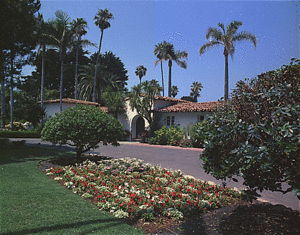

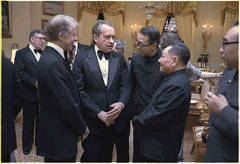
عهده
مرئيات
| ريتشارد نيكسون يتحدث عن لوبي إسرائيل في الولايات المتحدة وكيف يجب أن يتصرف الرئيس الأمريكي. |
| ريتشارد نيكسون: شاه إيران محمد رضا بهلوي لم يقمع خصومه بما يكفي. |
| ريتشارد نيكسون: لا فائدة استراتيجية للولايات المتحدة من وجود اسرائيل. |
| كيف تؤثر الدولة العميقة على انتخابات 2024 (مع آرون جود). |
صورة شخصية وعامة



الهوامش
- ^ "Richard Nixon Presidential Library and Museum" (PDF). سبتمبر 21, 2015. Archived from the original (PDF) on سبتمبر 21, 2015.
- ^ ريتشارد نيكسون (1913-1994)..مبدأ غوام، الجزيرة نت
- ^ نيكسون، ريتشارد ملهاوس، الموسوعة المعرفية الشاملة
- ^ أ ب Miller Center.
- ^ Lampton, David M. (2024). Living U.S.-China relations: From Cold War to Cold War. Lanham, MD: Rowman & Littlefield. p. 23. ISBN 978-1-5381-8725-8.
- ^ Minami, Kazushi (2024). People's Diplomacy: How Americans and Chinese Transformed US-China Relations during the Cold War. Ithaca, NY: Cornell University Press. p. 38. ISBN 9781501774157.
- ^ Ambrose 1989, p. 453.
- ^ خطأ استشهاد: وسم
<ref>غير صحيح؛ لا نص تم توفيره للمراجع المسماةGoh-Small - ^ Black, p. 778.
- ^ أ ب ت ث ج PBS, The Nixon Visit.
- ^ أ ب ت Black, pp. 780–782.
- ^ Ambrose 1989, p. 516.
- ^ أ ب ت Nixon Library, President.
- ^ Dallek, p. 300.
- ^ "Foreign Relations of the United States, 1969-1976, Volume I Foundations of Foreign Policy, 1969-1972". 2001-2009.state.gov.
- ^ "Vietnam War Deaths and Casualties By Month". The American War Library. Archived from the original on ديسمبر 4, 2013. Retrieved يونيو 22, 2012.
- ^ Drew, p. 65.
- ^ Black, p. 569.
- ^ Black, p. 591.
- ^ أ ب Owen, Taylor; Kiernan, Ben (أكتوبر 2006). "Bombs Over Cambodia" (PDF). The Walrus. pp. 32–36. Archived (PDF) from the original on أبريل 20, 2016. Retrieved يناير 29, 2012. Kiernan and Owen later revised their estimate of 2.7 million tons of U.S. bombs dropped on Cambodia down to the previously accepted figure of roughly 500,000 tons: See Kiernan, Ben; Owen, Taylor (أبريل 26, 2015). "Making More Enemies than We Kill? Calculating U.S. Bomb Tonnages Dropped on Laos and Cambodia, and Weighing Their Implications". The Asia-Pacific Journal. Archived (PDF) from the original on سبتمبر 12, 2015. Retrieved نوفمبر 15, 2016.
- ^ Clymer, Kenton (2013). The United States and Cambodia, 1969–2000: A Troubled Relationship. Routledge. pp. 14–16. ISBN 978-1-134-34156-6.
- ^ Ambrose 1989, pp. 281–283.
- ^ Address to the Nation on Vietnam Archived مارس 4, 2016 at the Wayback Machine May 14, 1969
- ^ أ ب Time 1971-04-05.
- ^ Mosyakov, Dmitry (2004). "The Khmer Rouge and the Vietnamese Communists: A History of Their Relations as Told in the Soviet Archives". In Cook, Susan E. (ed.). Genocide in Cambodia and Rwanda. Yale Genocide Studies Program Monograph Series. p. 54ff. Archived from the original on مارس 9, 2013.
In April–May 1970, many North Vietnamese forces entered Cambodia in response to the call for help addressed to Vietnam not by Pol Pot, but by his deputy Nuon Chea. Nguyen Co Thach recalls: 'Nuon Chea has asked for help and we have liberated five provinces of Cambodia in ten days.'
- ^ AP/St. Peterburg Independent.
- ^ Gitlin, Todd (1987). The Sixties: Years of Hope, Days of Rage. Bantam Books. p. 410. ISBN 978-0-553-37212-0.
- ^ خطأ استشهاد: وسم
<ref>غير صحيح؛ لا نص تم توفيره للمراجع المسماةSafire pp205–209 - ^ UPI/Beaver County Times 1970-05-09.
- ^ Black, pp. 675–676.
- ^ Ambrose 1989, pp. 446–448.
- ^ Evans.
- ^ Ambrose 1991, pp. 53–55.
- ^ Ambrose 1991, p. 473.
- ^ Ambrose 1989, pp. 379–383.
- ^ أ ب ت Kornbluh, Peter (2003). The Pinochet File: A Declassified Dossier on Atrocity and Accountability. New York: The New Press. ISBN 978-1-56584-936-5.
- ^ Black, p. 921.
- ^ أ ب ت BBC 1972-05-22.
- ^ David Tal, " 'Absolutes' and 'Stages' in the Making and Application of Nixon's SALT Policy." Diplomatic History 37.5 (2013): 1090–1116, quoting pp 1091, 1092. Nixon himself later wrote, "[W]e decided to link progress in such areas of Soviet concern as strategic arms limitation and increased trade with progress in areas that were important to us—Vietnam, the Mideast, and Berlin. This concept became known as linkage." Richard Nixon (1978). RN: The Memoirs of Richard Nixon. Simon and Schuster. p. 346. ISBN 978-1-4767-3183-4.
- ^ Gaddis, pp. 294, 299.
- ^ Nixon 1985, pp. 105–106.
- ^ Smith, Hedrick (يونيو 29, 1974). "OCCIDENTAL SIGNS DEAL WITH SOVIET". The New York Times (in الإنجليزية الأمريكية). ISSN 0362-4331. Retrieved ديسمبر 6, 2021.
- ^ "THE RIDDLE OF ARMAND HAMMER". The New York Times (in الإنجليزية الأمريكية). نوفمبر 29, 1981. ISSN 0362-4331. Retrieved ديسمبر 6, 2021.
- ^ أ ب Rich, Spencer (أكتوبر 4, 1979). "Soviets Dumping Ammonia, ITC Says". Washington Post (in الإنجليزية الأمريكية). ISSN 0190-8286. Retrieved ديسمبر 7, 2021.
- ^ "NIXON IN APPEAL ON SOVIET TRADE". The New York Times (in الإنجليزية الأمريكية). أكتوبر 5, 1973. ISSN 0362-4331. Retrieved ديسمبر 7, 2021.
- ^ Herring, George C. (2008). From Colony to Superpower; U.S. Foreign Relations Since 1776. Oxford University Press. p. 804. ISBN 978-0-19-507822-0.
- ^ أ ب ت ث Black, p. 963.
- ^ خطأ استشهاد: وسم
<ref>غير صحيح؛ لا نص تم توفيره للمراجع المسماةHanhimäki-Small - ^ "DEFCON DEFense CONdition". fas.org. Archived from the original on يونيو 17, 2015. Retrieved يونيو 17, 2015.
- ^ Nixon 1978, pp. 938–940.
- ^ Black, pp. 923–928.
- ^ Ambrose 1991, p. 311.
- ^ Tyler, Patrick (2010), p. 161
- ^ Black, pp. 951–952, 959.
- ^ أ ب Ambrose 1989, pp. 225–226.
- ^ أ ب Ambrose 1989, pp. 431–432.
- ^ أ ب ت خطأ استشهاد: وسم
<ref>غير صحيح؛ لا نص تم توفيره للمراجع المسماةBowles-Small - ^ أ ب Aitken, pp. 399–400.
- ^ أ ب ت ث Hetzel, p. 92.
- ^ Aitken, p. 395.
- ^ USPS, Periodicals postage.
- ^ أ ب Aitken, pp. 397–398.
- ^ أ ب Rinde, Meir (2017). "Richard Nixon and the Rise of American Environmentalism". Distillations. Vol. 3, no. 1. pp. 16–29. Archived from the original on أبريل 5, 2018. Retrieved أبريل 4, 2018.
- ^ Aitken, p. 396.
- ^ NHI: CQ Almanac 1971.
- ^ أ ب HMO: CQ Almanac 1973.
- ^ NHI: CQ Almanac 1974.
- ^ Ambrose 1989, p. 418.
- ^ Office of the Federal Register, pp. 179–182.
- ^ The American Presidency Project.
- ^ National Heart, Lung, and Blood Institute, p. 2.
- ^ Wailoo, pp. 165, 170.
- ^ Boger, p. 6.
- ^ Sabia.
- ^ Parmet, pp. 595–597, 603.
- ^ The Republican Reversal—James Morton Turner, Andrew C. Isenberg | Harvard University Press. Harvard University Press. نوفمبر 12, 2018. p. 36. ISBN 9780674979970. Archived from the original on يناير 8, 2019. Retrieved يوليو 31, 2019 – via www.hup.harvard.edu.
- ^ The Partisan Sort. Chicago Studies in American Politics. University of Chicago Press. p. 24. Archived from the original on يوليو 31, 2019. Retrieved يوليو 31, 2019.
- ^ Delaney 1970-07-20.
- ^ Frum, p. 246.
- ^ Frazier, Nishani (2017). Harambee City: Congress of Racial Equality in Cleveland and the Rise of Black Power Populism. University of Arkansas Press. pp. 184–207. ISBN 978-1-68226-018-0.
- ^ PBS, Nixon, Domestic Politics.
- ^ Parmet, p. 563.
- ^ Handlin.
- ^ Hepplewhite, ch. 5.
- ^ "MIT lecture notes in "Aircraft Systems Engineering," fall 2005, on early Space Shuttle policy" (PDF). Massachusetts Institute of Technology. Fall 2005. p. 7. Archived (PDF) from the original on أغسطس 26, 2014. Retrieved أغسطس 22, 2014.
- ^ Ezell, ch. 6–11.
سيرة ذاتية،
- Aitken, Jonathan (1996). Nixon: A Life. Washington, D.C.: Regnery Publishing, Inc. ISBN 0895267209.
- Ambrose, Stephen E. (1987). Nixon: The Education of a Politician 1913–1962. New York: Simon & Schuster. ISBN 067152836X.
- Ambrose, Stephen E. (1989). Nixon: The Triumph of a Politician 1962–1972. New York: Simon & Schuster. ISBN 0671725068.
- Ambrose, Stephen E. (1991). Nixon: Ruin and Recovery 1973–1990. New York: Simon & Schuster. ISBN 0671691880.
- Black, Conrad (2007). Richard M. Nixon: A Life in Full. New York: PublicAffairs Books. ISBN 1586485199.
- Blythe, Will (2006). To Hate Like This is to be Happy Forever. New York: Harper Collins. ISBN 006074023X.
- Boger, John Charles (2005). School Resegregation: Must the South Turn Back?. Chapel Hill, N.C.: UNC Press. ISBN 0807856134.
- Dallek, Robert (2007). Nixon and Kissinger: Partners in Power. New York: HarperCollins. ISBN 0060722304.
- Drew, Elizabeth (2007). Richard M. Nixon. The American Presidents Series. New York: Times Books. ISBN 0805069631.
- Evans, Rowland; Novak, Robert (1971). Nixon in the White House: The Frustration of Power. New York: Random House. ISBN 0394462734.
- Ferris, Gary W. (1999). Presidential Places: A Guide to the Historic Sites of the U.S. Presidents. Winston Salem, N.C.: John F. Blair, Publisher. ISBN 0895871769.
- Foner, Eric (2006). Give Me Liberty!: An American History. Vol. 2. New York: W. W. Norton & Company. ISBN 0393927849.
- Frick, Daniel (2008). Reinventing Richard Nixon. Lawrence, Kans.: University of Kansas Press. ISBN 9780700615995.
- Frum, David (2000). How We Got Here: The '70s. New York: Basic Books. ISBN 0465041957.
- Gaddis, John Lewis (1982). Strategies of Containment: A Critical Appraisal of Postwar American National Security Policy. Oxford: Oxford University Press. ISBN 0195030974.
- Gellman, Irwin (1999). The Contender. New York: The Free Press. ISBN 1416572554.
- Guan, Ang Cheng (2003). Ending the Vietnam War: The Vietnamese Communists' Perspective. Florence, Ky.: RoutledgeCurzon. ISBN 0415406196.
- Hetzel, Robert L. (2008). The Monetary Policy of the Federal Reserve. New York: Cambridge University Press. ISBN 0521881323.
- Morris, Roger (1990). Richard Milhous Nixon: The Rise of an American Politician. New York: Henry Holt and Company. ISBN 0805018344.
- Nixon, Richard (1978). RN: The Memoirs of Richard Nixon. New York: Grosset & Dunlap. ISBN 0448143747.
- Nixon, Richard (1985). No More Vietnams. Westminster, Md.: Arbor House Publishing Company. ISBN 0877956685.
- Parmet, Herbert S. (1990). Richard Nixon and His America. Boston: Little, Brown and Company. ISBN 0316692328.
- Reeves, Richard (2001). President Nixon: Alone in the White House. New York: Simon & Schuster. ISBN 0684802317.
- Schulzinger, Robert D. (2003). A Companion to American Foreign Relations. Oxford: Blackwell Publishing. ISBN 1405149868.
- White, Theodore H. (1973). The Making of the President 1972. New York: Antheneum Publishers. ISBN 0689105533.
- Zhai, Qiang (2000). China and the Vietnam Wars, 1950–1975. Chapel Hill, N.C.: University of North Carolina Press. ISBN 0807848425.
وصلات خارجية
- Richard Nixon Foundation
- The Nixon Center, Washington, D.C.
- Richard Nixon Presidential Library
- White House biography
- Richard Nixon: A Resource Guide from the Library of Congress
- The Watergate Tapes
- Nixon's will
- Appearances on C-SPAN
- Richard Nixon at the Internet Movie Database
- ريتشارد نيكسون at the دليل سـِيَر الكونگرس الأمريكي
- Works by or about ريتشارد نيكسون in libraries (WorldCat catalog)
- أعمال من Richard Nixon في مشروع گوتنبرگ
- أخبار مُجمّعة وتعليقات عن ريتشارد نيكسون في موقع صحيفة نيويورك تايمز.
- The Nixon-Presley Meeting at The National Security Archive
| Titles and Succession | ||||||||||||||||||||||||||||||||||||||||||
|---|---|---|---|---|---|---|---|---|---|---|---|---|---|---|---|---|---|---|---|---|---|---|---|---|---|---|---|---|---|---|---|---|---|---|---|---|---|---|---|---|---|---|
| ||||||||||||||||||||||||||||||||||||||||||
خطأ استشهاد: وسوم <ref> موجودة لمجموعة اسمها "lower-alpha"، ولكن لم يتم العثور على وسم <references group="lower-alpha"/>
- CS1 الإنجليزية الأمريكية-language sources (en-us)
- Short description is different from Wikidata
- Articles with hatnote templates targeting a nonexistent page
- Missing redirects
- Articles with hAudio microformats
- Pages using authority control with unknown parameters
- Portal-inline template with redlinked portals
- Pages with empty portal template
- Use mdy dates from June 2011
- مقالات جيدة
- ريتشارد نيكسون
- مواليد 1913
- وفيات 1994
- أمريكان مناهضون للشيوعية
- محامون أمريكان
- عسكريون أمريكان من الحرب العالمية الثانية
- أمريكان من حرب فيتنام
- American Quakers
- جمهوريو كاليفورنيا
- Cardiovascular disease deaths in New York
- وفيات بنوبة قلبية
- Disbarred lawyers
- Duke University School of Law alumni
- أشخاص من ادارة أيزنهاور
- تاريخ الولايات المتحدة (1964–1980)
- أعضاء مجلس النواب الأمريكي عن كاليفورنيا
- أشخاص من ادارة نيكسون
- أشخاص من مقاطعة أورانج، كاليفورنيا
- People from San Clemente, California
- أشخاص من وايتر، كاليفورنيا
- رؤساء الولايات المتحدة
- حاصلون على عفو رئاسي أمريكي
- رؤساء الولايات المتحدة من الحزب الجمهوري
- مرشحو الرئاسة الأمريكية من الحزب الجمهوري
- سنتاورات من الحزب الجمهورية
- نواب رؤساء الولايات المتحدة من الحزب الجمهوري
- ضباط البحرية الأمريكية
- مرشحون الرئاسة الأمريكية 1960
- مرشحون الرئاسة الأمريكية 1968
- مرشحون الرئاسة الأمريكية 1972
- سناتورات أمريكان من كاليفورنيا
- نواب رؤساء الولايات المتحدة 1952
- United States vice-presidential candidates, 1956
- نواب رؤساء الولايات المتحدة
- Watergate figures
- خريجو وايتر كولدج
- كتاب من كاليفورنيا
- كتاب من نيويورك

